Bamford Grange: A Lost House in Adswood
Davenport Station home | Index to History pages
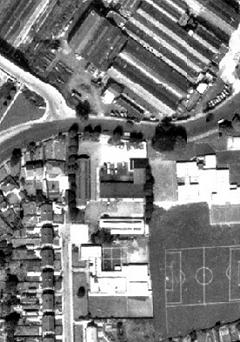
Bamford Grange (centre of the picture) from the air, circa 1970.
Gabrielle Ray

Bamford Grange's most famous resident, Gabrielle Ray (real name Gabrielle Elizabeth Clifford Cook) was born 28 April 1883. She made her first stage appearances as a child. In 1893, after moving to London with her mother she could be found under the name of Bessie Ray, playing the part of Eveleen in 'Miami', at the Royal Princess's Theatre, Oxford Street. She also danced in Paul Valentine's 'Blackpool ballet' and appeared as a winsome cupid in 'Little Red Riding Hood' at Richmond before joining a touring company in 1899. playing in 'The Belle of New York' and 'The Casino Girl.' The 1901 census records her as Bessie Ray in lodgings in Birmingham during one of these tours.
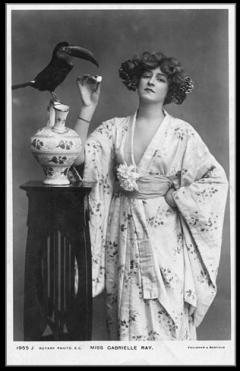
One of the hundreds of postcard pictures of Gabrielle Ray that were published in her lifetime.
In 1902, she was playing the title role in the pantomime Little Red Riding Hood at the Lyric Theatre, Hammersmith, produced by John East. East's son, John M. East, wrote in his book Neath the Music:
'Early that evening, there was a gasp of admiration as an enchanting vision of loveliness floated on to the stage, with large blue eyes and a heart-shaped face framed in a mist of burnished golden hair. She moved with graceful fluidity; her dancing was such that her feet scarcely touched the boards. This was Red Riding Hood herself. Her success was assured from that very first entrance. During the interval, everybody checked their programme for the name of this unknown artist. It was Gabrielle Ray, nineteen years of age, and at the threshold of her dazzling career.'
On the first night of this production she came to the attention of George Edwardes (1852-1916), the famous manager of the Gaiety and Prince of Wales Theatres who took her into his company. She played the suggestible ministerial secretary, Thisbe, at the new Gaiety Theatre in 'The Orchid' (1903) and became established as one of the so-called 'Gaiety Girls.' By now billed as Gabrielle Ray, she was noticed by a writer for The Tatler magazine: 'Miss Gabrielle Ray ... gives promise of qualifying to win a place in the long roll of famous dancers; Miss Ray is neither French or American as is surmised but comes from Lancashire.' The show ran for 559 performances, and was seen by His Majesty King Edward VII and Queen Alexandra.
In 'The Little Cherub' (1906), Gabrielle, by now one of the most popular picture-postcard beauties of the day, shared the stage with, among others, Lily Elsie, another girl from Lancashire - see note below - in this and other shows. Later, playing Frou-Frou in 'The Merry Widow' (1907) she supported Lily Elsie in her most famous role; many thought Gabrielle 'stopped the show' with her whirling dance routine with handstands and high kicks, all performed on a table at Maxim's, held head-height by four men. 'The Merry Widow' ran to 778 performances.
After appearing in further shows in 1909 - 1912, she decided to abandon her stage career and marry a wealthy admirer, Eric Raymond Loder (1888 - 1966) in 1912. Loder was some years younger than her, and 'came from a racing family and had outdoor interests ranging from big game hunting to driving fast cars.'
She failed to turn up at the first attempt at a wedding, but the marriage when completed at the second attempt was an unhappy one, and after two years they divorced. They had no children.
In 1916 she made a stage comeback, appearing various reviews and pantomimes including a 'Mother Goose' with comedian Dan Leno for Christmas 1920 at the Theatre Royal, Manchester.
Eventually she retired to a life of unhappy seclusion, and in 1936 suffered a mental breakdown, and spent the rest of her life in mental hospitals. She died, aged 90 in 1973 and is buried at Englefield Green cemetery in Surrey
In a curious twist of fate, on the site of her birthplace there now stands a home for people requiring mental heath care.
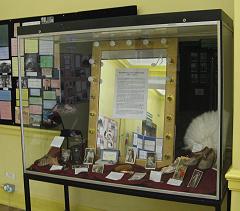
Another coincidence is that unknown to this author at the time I started researching this item late in 2013, the staff of Stockport Heritage Library were preparing their own tribute in the form of a display of artefacts in the Library (pictured above) and an article in Now and Then: Stockport Heritage Library Newsletter, Winter 2013.

Gabrielle Ray on the Web
Gabrielle Ray has achieved posthumous fame on the World Wide
Web with several websites devoted to her life and work,
often written by collectors of the many postcard portraits
which can be found for sale at low prices on auction sites
such as eBay.Thanks are due to the authors of all the sites linked below from whom I have borrowed information. Special thanks for due to the amazing Summerland76 site, whose author has compiled an amazing collection of documents about Gabrielle and her family, and placed them all online. Without them the Cook section of our feature would have taken much more time and expense.
Some other Ray sites:
Gabrielle Ray biography by Sydney Higgins
Gabrielle Ray in the Oxford Dictionary of National Biography
Gabrielle Ray by Don Gillan
gabrielleray.com by H. Jarenko
A Postcard Tribute by Josie Walsh
Miss Lily Elsie
By way of a digression, a few words about Gabrielle Ray's fellow Gaiety Girl, Lily Elsie (1886-1973), born Elsie Hodder, who later took her mother's husband's name Cotton. Her career paralleled in several respects that of Gabrielle Ray. She was born in much poorer circumstances, however, in a small house in Salford, where her mother was a friend of some of the backstage workers from the local theatres.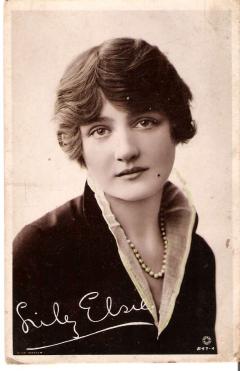
As a child in Salford, she appeared on stage with a music troupe including Joseph Worthington, house painter and amateur performer, grandfather of my wife's sister-in-law. The postcard reproduced here belonged to Joseph's daughter Edna Worthington, who has written on the back:
'Lily Elsie was born and raised in Salford & sang her first song on the stage with my father when he belonged to the Temperance [?] Troup. She gave up the theatre & married a millionaire. When big in London in her early years she always sent flowers to her mother in Salford on a weekly basis.'
I think this refers to the Saturday evening entertainments held at the Temperance Hall in Salford.
Her millionaire admirer and husband was Major John Ian Bullough (1885–1936), the son of wealthy textile manufacturer John Bullough of Accrington, Lancashire. (She was actually his second wife: he had married another actress, Maudi Darrell, in 1909, only for her to die of an illness the following year.) His marriage to Lily Elsie was apparently not always a happy one; she became increasingly unwell and mentally unstable, and they divorced in 1930. Like Gabrielle Ray, she had no children.
She did make something of comeback to show business in the 1920s, appearing in touring musicals 'The Blue Train' and 'The Truth Game'. The postcard dates from that period, perhaps given when she was appearing in Manchester.
She retired to a semi-reclusive life in a cottage in Sussex, although she made occasional public appearances such as a reunion of Gaiety Girls' in 1946. her last years were spent at St. Andrew's Hospital in London where she died in 1973.
Her life is also comprehensively covered by websites: www.lily-elsie.com for example, and a detailed printed biography Anything but Merry by David Slattery-Christy which also has a website.
Arthur Harrop's collections
After the death of Arthur Jenkins Harrop, not only Bamford Grange itself but also its contents were sold, an auction being held at the house on 9 and 10 July 1913. The list of items reveals some of the hobbies of an Edwardian gentleman. Mahogany bookcases, wardrobes, sideboard, chest of drawers and dining toiler tables, engravings and mezzotints were all included, as well as:Old English China, including choice examples of Worcester, Derby Crown Derby, Spode, Staffordshire, Dresden, and Wedgwood ware, nearly all marked and in factory condition; a quantity of find old cut class.
The Library of about 700 books, including "The London Theatre" by Dibdin, 1818; "Humphrey Clinker", 1789; "Hudibras", "Syntax Tours" and "Vicar of Wakefield"; Rowlandson's coloured plates; "Exotic Gardener", 1814; "Curtis and Smith's Botany", 1804; "La Belle Assemblee", 1814-1832; "Ackermann's Repository", 4 vols.; Waverley Novels, and others.
600 ounces of Georgian silver, chiefly from 1770 to 1810. Including Tea and Coffee service, 1809; Hot Water Jug, 1789; Cream Jug, 1812; Embossed Mug, 1816; Coffee Pot, 1778; Sugar Caster, 1779; Cruet Stand, Dessert Knives and Forks and Table Silver.
Also the Fine Old Sheffield Plate, consisting of Set of Fine Fluted Candlesticks, 13 in. high, with branches; Centre Stand, with twisted branches and cut glass dishes; Extending Candlesticks, sets of Coasters, etc., all in new condition.
Jewellery, comprising Heavy Gold Lever and Verge Watches; Gold Watch Chain, Gold Chain and Fob; Pearl Collarette, with Earrings Brooches and Head Ornaments; Gold Brooches, Rings, etc.
Mr Harrop had also invested in property in Altrincham, which featured in an auction in Manchester on 15 June. He owned 48 cottages, 5 shops and part of the land of a Wesleyan Sunday School, all in the New Street, Regent Road and Hope Square areas on Altrincham, which had provided him with rental income of over £600 per year, equivalent around £50,000 in 2011.
Unfortunately for whoever bought them, however, Chief Rents of this kind had no provision for inflation, so they would still generate £600 today.
(Source: Manchester Guardian, 5 July 1913)
Shaw Heath Laundry

Cheshire Directory, 1906
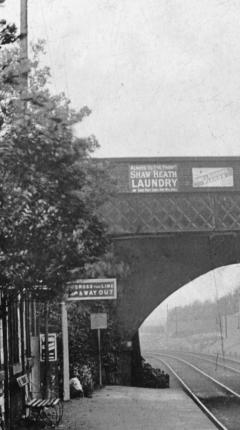
This detail from an Edwardian picture of Davenport station shows advertising for the Shaw Heath Laundry with its slogan 'Always to the Front'.

This map shows the Lowfield Road area in 1910 with the Laundry marked in green.
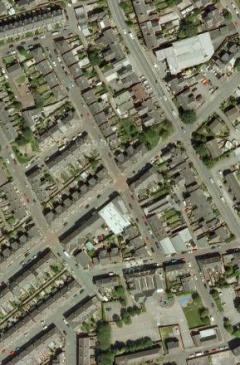
An aerial view by Google a century later shows remarkably little change. A modern office building has replaced a large house on Shaw Heath, Broadhurst Street has been extended, and the laundry complex, now in other industrial use, is bigger than the old picture, but the basic street pattern remains along with most of the same houses.
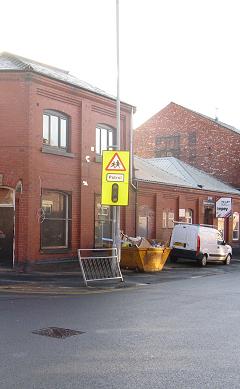
The laundry site in 2014: the single-storey buildings are the originals seen in the Edwardian picture.
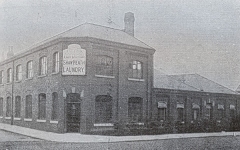
The other buildings would have been added as the laundry business grew; the two-storey building on the left was fitted into the wedge-shaped space at the street corner, as seen in the above newspaper picture, dated 1911 by Stockport Library.
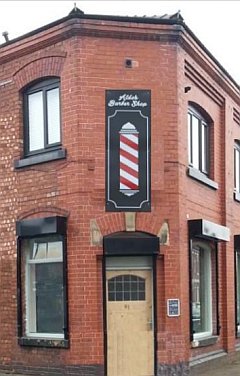
In 2015, part of this extension became Aldo's Barber Shop.
Nathaniel Gould's shops


Thanks to:
The staff of Stockport Heritage Library for their assistance with this feature, and for their invaluable Image Archive.
Howard Piltz for his memory of the Harroways.
Other sources:
Electoral Registers on microfilm (Stockport Library)
Stockport Directories (Stockport Library)
www.ancestry.co.uk
Cheshire Directories online
Cheshire Tithe Maps
Historical Directories
Old-Maps.co.uk
'The Index Figure' Spectator archive for 11 December 1920
Guardian and Observer online archive
We will be very interested to hear of any personal memories of this building and its residents.
Contributions are very welcome at at info@davenportstation.org.uk

On the front wall near the entrance is a blue plaque commemorating Gabrielle Ray, born on this site April 28th 1883: 'Gaiety Girl, actress, singer and dancer, she was the most photographed stage beauty of the Edwardian Age.' The plaque, sponsored by the Gabrielle Ray Appreciation Society and installed by Stockport Council, was placed there in 2008, and was the first such plaque in Stockport to have a woman as its subject.
However, like some other celebrated natives of Stockport such as Fred Perry and Joseph Whitworth, she left the area while still a child. Her show business career ended in 1920, and she died in 1973, but today she is much celebrated on the Internet and elsewhere; her information folder in Stockport Heritage Library is one of the thickest in the collection, so there is little that we can add to the biography of Gabrielle Ray herself, summarised in the left-hand column, but while passing Bamford Grange one day in 2013, I decided to investigate the story of the buildings that have previously stood on that site, and their residents.
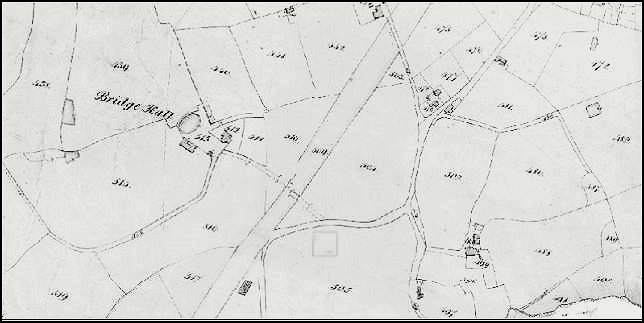
The Tithe Map dating from the 1840s (above) shows that historically, the field concerned, known as 'Madge Field' was in the Township of Cheadle Bulkeley, part of the Parish of Cheadle, and the area was one of the scattered farmsteads as can still be seen in rural parts of Cheshire today, with the beginnings of encroachment by railways, in the form of the London and Birmingham Railway, which today we know as the line from Stockport to Cheadle Hulme. The Madge Field was part of Adswood Hall farm, based at the old Hall which dated from 1659, said one of the first brick-built houses in the area. The farmer in 1861 was Benjamin Chetham, but the land was owned, like much of the land in our area, by Lloyd Hesketh Bamford Hesketh of Gwrych Castle, near Abergele. He died in 1861, and the estates passed to his son Robert, and in 1894 to Robert's daughter Winifred, Countess of Dundonald. Their family names can still be found in those of various streets and buildings around their lands, including the Bamford Arms public house in Heaviley, and it would seem that Bamford Grange follows this tradition.

A lease dated 28 December 1861, for a period of 999 years, applied to a one-acre part of the Madge Field alongside what was then called Adswood Lane, opposite the track leading to Bridge Hall farm, and on it was built a house which on the Ordnance Survey of 1872 (above) is called 'Bamford Lodge.'

The picture above, from the auction leaflet of 1913, shows how the house looked. Its very earliest days are obscure, as the Land Registry records do not go back to its origin. Whether it was commissioned by its first resident or built by the Bamford Hesketh estate remains to be discovered. It did not appear in the 1861 Census, which suggests it was built in the 1860s, making it one of the first 'new' houses in the area.
Captain Lloyd
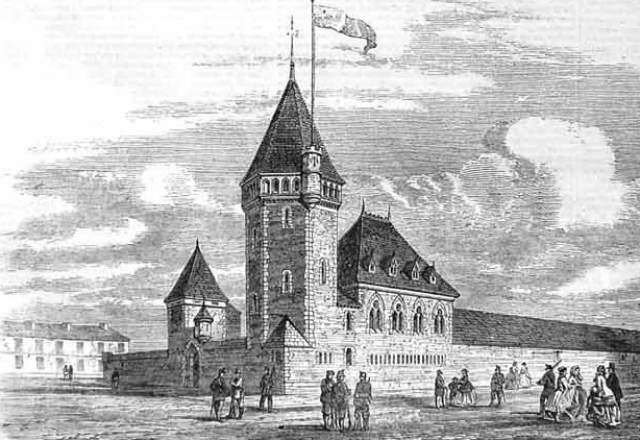
The census record for 1871 does not give house names, but based from his position on the census listing next to George Atkinson who is known from later records to have lived at nearby Holly House, it is likely that an early resident, if not the first, was Captain Francis Lloyd, who on 10 November 1860 who had been awarded the post of Adjutant to the 4th Battalion of Cheshire Rifle Volunteers, based at the Stockport Armoury, opened in 1862 (above), which still stands in Greek Street, Edgeley, Stockport. Born in Warburton, in rural Cheshire, Captain Lloyd (aged 47) was resident in Bamford Lodge in 1871 with his wife Mary and servants Sarah Wheetton, Mary Higginbottom and James Wyke. Soon afterwards he retired and moved with his wife to Devon.
The Cooks
The next householder to consider is William Austin (or Augustine) Cook, the father of the famous Gabrielle Ray. He was born in Hathersage, in the Hope Valley area of Derbyshire, a place which we associate with pleasant scenery, but for many years Hathersage was an industrial settlement. William's father, Robert Cook, moved there with his brother David from the Redditch area of Worcestershire, known for its needle manufacturers, about 1811, and set up in business in Hathersage. They created the Barnfield works to make needles, and similar items needed by the textile industry, and lived in nearby Barnfield House. Robert Cook died in 1866, and his eldest son Robert Charles Cook took over the firm. William, his third son, born 1846, left for the Manchester area where he set up in business as an iron merchant. The 1871 census finds him lodging with a couple at 328 Oxford Road, Chorlton-on-Medlock, Manchester. In 1873, living in Stretford, he married Annie Maria Elizabeth Holden at St Ann's Roman Catholic Church in Stretford, and by 1874 the couple had moved in to Bamford Lodge, which was named as such in a directory published that year. In 1880, William was appointed as a Magistrate for Stockport, apparently despite his application having been rejected by a vote of the Town Council.
By 1881 they had renamed it Bamford Grange and had children: Darcy Austin Cook (b.1874), Edith Mary Ferdinanda Cook (b.1876), and Gladys Maria Clifford Cook (b. 1879) and the household also included a nurse, under nurse, cook and coachman. Beatrice Mary Marcalla Galway Cook was born in 1881, Gabrielle Elizabeth Clifford Cook in 1883, and Edward Holden Cook in 1884. By this time the Cooks' personal and business lives were starting to unravel. William became involved in some dubious companies promoted by a Walter Pitt, including the Staffordshire Union Bank and the Globe Wine Company, followed by the Cheshire Banking Company which merged with the Staffordshire Union Bank. All these enterprises failed with consequent loss to their gullible shareholders. He was accused and acquitted of Forgery, made bankrupt and was suspended from his post as a Justice of the Peace.
Annie, who had become head of the business due to William's bankruptcy, became 'romantically involved' with her Scottish-born accountant James Johnstone (who was married with three children) and Barbara Cook, born in 1888, was in fact Johnstone's child. By 1891, James Johnston and Annie had moved to London and were living as man and wife in Stockwell with Darcy, Gabrielle and Edward Cook as well as their own children Barbara and Dallas. By the time she was ten years old, Gabrielle's stage career had begun, and from her teenage years, under the management of George Edwardes and with a new name she became the famous Edwardian beauty Gabrielle Ray.
By 1888, when Barbara was born, the Cooks had left Bamford Grange for a more modest residence, 137 Upper Brook Street, Chorlton-on-Medlock, Manchester, not far from William's business address at 35 Oxford Street in Manchester City Centre. In 1893 the couple were divorced, and by 1901 William also had left for London where he married Caroline Gertrude Hunt. In the 1911 census, it appears he was running some kind of hotel. He died in 1920.
Arthur Harrop
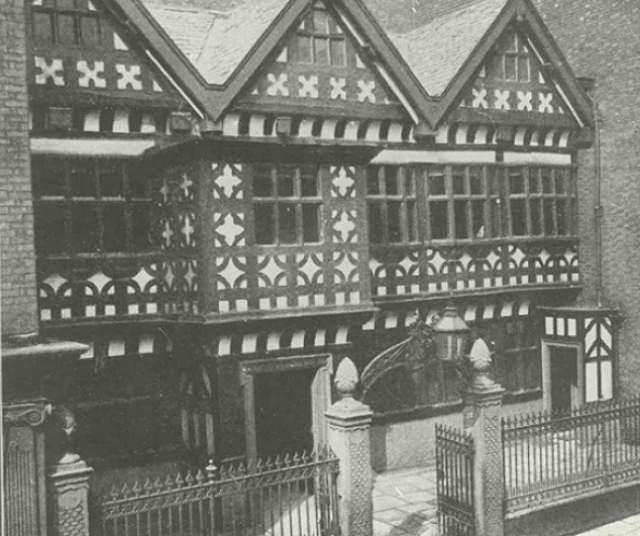
The next resident of Bamford Grange was Arthur Jenkins Harrop, who was the manager of the Stockport branch of the Manchester and Liverpool District Bank, based in Underbank Hall, the black-and-white Tudor townhouse which still stands, and operates as a bank, in 2014. The picture above, taken by the firm of Bullock Brothers, shows the building in Mr Harrop's day. It was the town house of the Arden Family until 1829 when it was sold by auction and became a bank, which by takeovers and mergers over the years became a branch of the District Bank and then the Natwest. The District Bank had a taste for black-and-white architecture, either original or replicated; The former bank branch in Prestbury, Cheshire East, was built in the sixteenth century as a 'priest's house' and is a Grade II* listed building. Examples of replica tudor can be found in the now-closed branches at Station Road, Cheadle Hulme, and Shaw Heath, Stockport.
Born in Northenden, Cheshire in January 1842, Arthur Harrop transferred to Stockport in the 1880s from Todmorden where he had been managing the bank branch there, although he knew Adswood well. In 1861 both Mother and Grandmother gave their occupation as 'Railway Shareholder.' His father John Harrop, an Attorney-at-law whose office was on Rostron Brow in Stockport, married London-born (Mary) Eleanor Jenkins Austin in 1833. Their home by 1841 was Sharston Mount, a large and historic farmhouse in Northenden which at the time was surrounded by fields and still survives as a listed building amid modern housing.
John Harrop died when Arthur was very young, and after living in Wilmslow for a while the family, including his grandmother Mary Davy and his three brothers, voved to Mary's birthplace, Lampeter in Wales. Arthur had returned to the Stockport area by 1861 and 1871 he was working as a bank clerk, later a cashier, in Stockport and living with his mother (Mary) Eleanor Harrop and his grandmother Mary Davy in an unpretentious house not far from Bamford Grange.
Arthur's mother died (in December 1886) soon after he brought her back from Todmorden to live in Bamford Grange, and he lived there unmarried, with two servants, until his death in 1913, occasionally making the news by giving evidence against fraudsters in criminal trials, including one at the 'Old Bailey' in London. In 1887 he became involved in some legal proceedings involving his brothers and nephews regarding their inheritance.
His servants in 1911 were Esther Roberts (46), cook, born in Montgomeryshire, and Edith Willett (22) Housemaid, born in Herefordshire.
Details of Arthur's will, published in 1913 (see left column), give some idea of his friends and interests. He left assets valued at over £50,000, and bequeathed £2000 to the Royal Society for the Prevention of Cruelty to Animals, £500 each to the National Society for the Prevention of Cruelty to Children, Dr Barnardo's Homes and Stockport Infirmary, £300 to to the Stockport Sick Poor Nursing Association, £200 to the Stockport Association for the Stockport Association for the Blind, Deaf and Dumb, and '£1000, all his wines, spirits and liqueurs, and "Ormerod's History Cheshire" to his old friend Dr. Edwin Rayner, of Cheadle Hulme. The residue was to be divided equally between the children of his brother Edward Davy Harrop, formerly a bank manager at Launceston, Tasmania.
Bamford Grange was auctioned soon after his death in 1913, and from the auction document, preserved in Stockport Heritage Library, we can quite a description of the property:
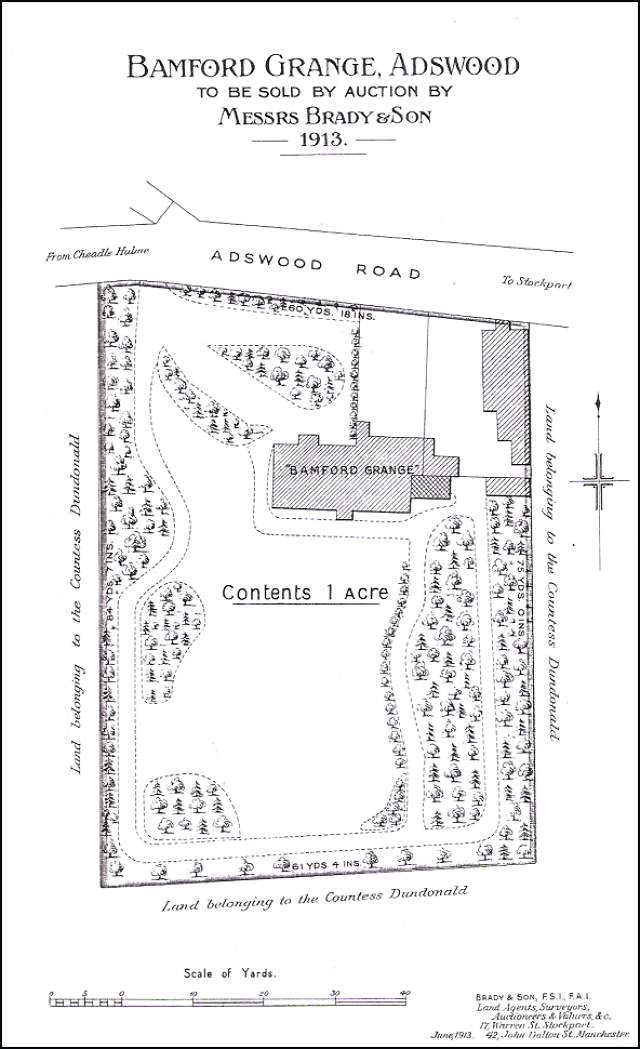
About a mile from Stockport station (L & N.W. Railway), on the Cheadle Hulme Road, in a secluded but convenient situation, surrounded by well-gown ornamental timber and shrubs, and having an exceptionally fine open view to the south over the Cheshire country. The accommodation comprises :
Dining Room, 23 ft. by 18 ft., with large Bay Window facing south.
Drawing Room, 18 ft. by 14 ft. 6 in., with Windows facing south and west.
Breakfast Room, 15 ft. by 11 ft. 6 in., with Window facing south, and entering into conservatory, and small Business Room.
Spacious Hall and Vestibule.
Light Oak Staircase.
Five Bedrooms (one of which has bath), and W.C.
Kitchen, Scullery and Pantry, and Cellared throughout.
The Outbuildings comprise 2-stall stable, Coach House, Harness Room with Loft Over, Laundry, &c.
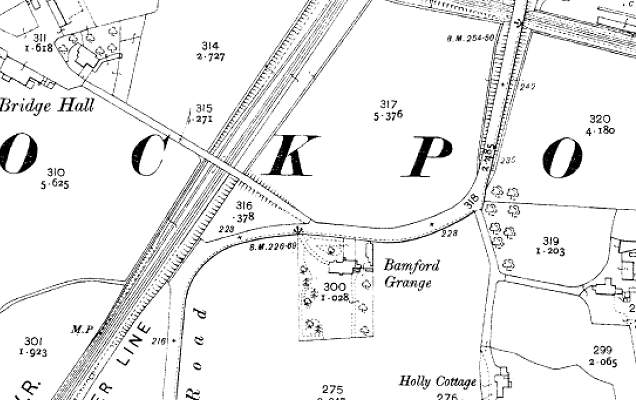
The map from 1910 shows that the house was indeed still surrounded by farmland, and at 228 feet above sea level would have had a fairly expansive view. Nearby, Holly Cottage was the home of George Atkinson, an architect. At Slain Farm, until his death in January 1910, lived Charles Alldis Brady, farmer and auctioneer, whose firm conducted the Bamford Grange auction. Two railways passed nearby, but both were in cuttings, so probably did not disturb Arthur's peace too much.
The Machins
The next residents of Bamford Grange after 1913 were Thomas Hall Machin (born Stockport 1868), and his wife Edith Louisa Machin (1875-1963). Thomas's father was a Yorkshire-born shoemaker who settled in Middle Hillgate, Stockport.
Earlier in their married life (they married in 1899) they had lived at 14 Woodbine Crescent, Heaviley. The 1901 census shows that Thomas made his living as a 'bicycle factor', a fashionable and lucrative business at the time, and by 1911 when they were at 69 Beech Road, Cale Green with their young son Clifford Machin.
Thomas used the proceeds from his bicycle business to set up the Shaw Heath Laundry in Lowfield Road, which opened for business sometime after 1901; it appears in a Cheshire directory for 1906.

Stockport Library's image archive includes some pictures of the laundry (above) and its delivery vans which date from Machin's time. The laundry was built on the south side of Lowfield Road, on the western corner with Broadhurst Street, an area that had still been undeveloped at the time of the 1898 Ordnance Survey map.
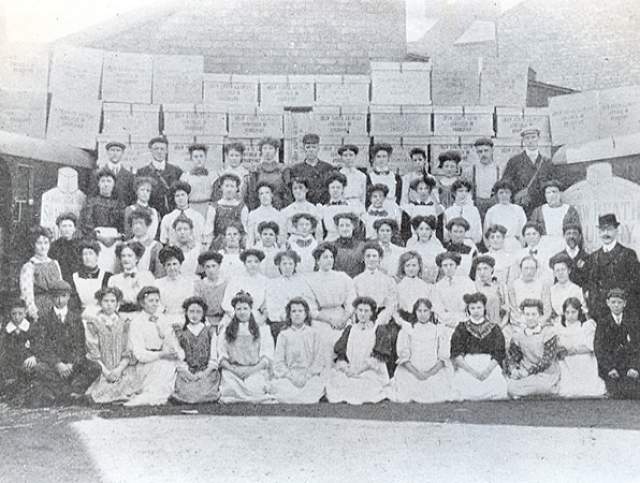
A staff portrait: is that Thomas Machin in suit and hat on the right?

Inside the laundry, with what look like ironing machines. Note the hazardous unprotected drive belts which were considered normal at the time. The overhead shafts would have been connected to a steam, or possibly gas, engine. The laundry continued in business for many years under new management after Mr Machin retired (he died in 1950), finally closing its doors in 1962; its contents were sold, along with delivery vans and a Zephyr car, in an auction held on-site.
The Harroways
In 1921, the Machins moved to 9 Davenport Park Road, in the Davenport Park private estate, and Bamford Grange was back on the market. The sellers would still able to claim it was 'secluded', as industry and housing was yet to encroach on its peace. The buyer was John Harroway, who moved in with his wife Hilda. It seems they converted the coach house into a separate dwelling, perhaps for their servants, as the 1930 Electoral Register records a John Hardman and Edith Hardman living at 'The Lodge.'
John Harroway was born in Blyth, Northumberland on 12 September 1872; his father was a 'mariner'. By 1891 he had left home and was in lodgings in Salford working as a Grocer's assistant. A 1914 Directory lists a Jonathan Harroway, grocer at 13 Higher Hillgate, Stockport, which may well be him. From this beginning he rose to be the owner of a local chain of grocery shops, Nathaniel Gould and Co. The firm had been founded in 1848 as a tea merchant in Market Street, Manchester by Derbyshire-born Nathaniel Gould (1824 - 1874). Harroway purchased the business, but kept the Gould name. Nathaniel's son Nathaniel (usually known as Nat Gould) lived in Australia for some years, and became a famous writer and novelist.
By 1911 John Harroway was living with his wife of seven years Hilda Beatrice Harroway (born in Chatham, Kent) son Cecil Harroway (aged 6) and a General Servant, Mary Dutton, at 'Westleigh', 222 Stockport Road, Cheadle Heath. He was a man with political ambition: he stood as a Liberal candidate in the 1922 Stockport Council election, and won the seat. In professional life he was a major voice in the Grocers Federation of the United Kingdom and the Northern Council of Grocers Associations. In this capacity he was moved to write to the Manchester Guardian in November 1920 in response to an official report stating that the cost of living index was 176% greater that it had been before the World War. He claimed this was a 'misstatement' because, among other examples he offered:
The cost of butter they give as 300 per cent up, yet people only get 1 oz. of butter per head and for the rest substitute margarine, which actually means a credit to reduction instead of an increase ... Cheese consumption has increased by 400 per cent, because it is taking place of meat, and so on.A statement worthy of a 21st century politician, you might think, but the authors of letters to the editor were not impressed by his logic.
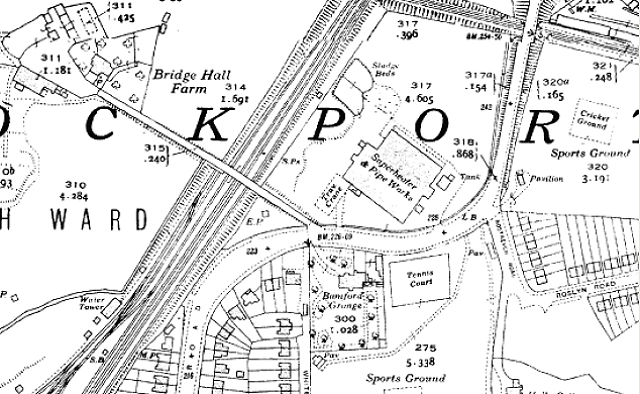
By the time of the 1934 map above, the bucolic charm of Bamford Grange had been somewhat lessened by the construction of the Superheater and Pipe Works with its travelling crane just across the road, and a housing estate on the fields of the former Adswood Hall Farm. The last farmers, the Lomax family, retained a small part near the Adswood Road railway bridge, which continued to trade until 2008.
The Harroway family appear to have remained at Bamford Grange for many years, although the 1923 Kelly's directory, a publication not renowned for its accuracy, mysteriously contains two entries as below:
Harrower John, 34 Peel Moat rd. Heaton MoorWhat this means is far from clear, perhaps they did live in Heaton Moor for a short while; a 1934 directory also has 'Jn. Harroway' at 34 Peel Moat Road, perhaps left in by mistake, but the 1939 register lists the family still at Bamford Grange. In 1953 they moved to 53 Haddon Road, Hazel Grove. John died in 1957, his widow Hilda lived until 1969.
Harrowing John, Bamford grange, Adswood
Branches of 'Nathaniel Gould and Company, Grocers, Wines and Spirits', according to the street directories, included at various times:
119 Denmark Road, Manchester
16 Moss Lane West, Manchester
462 Wilbraham Road, Chorlton-cum-Hardy
18 Lower Hillgate, Stockport
8 Bridge Street, Stockport
110 Shaw Heath, Stockport
216 Bramhall Lane, Davenport (next to the 'Jolly Sailor' pub)
92 Church Lane, Marple
8 Union Road, New Mills
14 Station Street, Urmston
The firm went into liquidation during World War II, although it was resurrected after the war as 'Nathaniel Gould & Co (1949)' and the shops in Stockport and Urmston were trading under that name in 1951, appearing for the last time in 1963, by which time the Bridge Street branch had already closed.
The firm seems to have been a pioneer of selling alcoholic drinks in a grocery shop: The 1902 Directory lists the Bridge Street shop as 'agents for W. & A. Gilbey Limited, wine & spirit Merchants', and there are records of licences being refused for the Manchester shops. 110 Shaw Heath is now the address of the 'Florist' pub: presumably the shop would have been adjacent.
In the 1930s the firm also owned the 'Cecil Café' at 26 Princes Street, Stockport, which was run by Cecil who is described in the 1939 Register as 'restaurant manager'. In addition Cecil became a director of ‘Exors of James Mills’ a steel processing plant that was on the Hyde side of Bents Lane, Bredbury. It may be that he took over the directorship from his father John.
Howard Piltz writes:
I met both John Harroway and his wife Hilda (generally referred to as Hilter - with a ‘t’) at Bamford Grange, probably in the mid-1950s and fortunately have inherited some vintage furniture from the house.Cecil Harroway died, aged 90, in 1995.
When I was a toddler, Cecil Harroway and his wife Mary lived on Macclesfield Road, adjacent to the railway line from Chinley, and became a good friend of my parents; we lived at 53 Haddon Road, just around the corner. When my parents and I moved to Romiley in December 1953 the Harroways (Mary and Cecil did not have any children) bought our house, but when Cecil retired he moved again, first to Anglesey Drive, Poynton, then to Treaddur Bay, Anglesey.
Later Days

After the Harroways left, sometime after 1939, the house ceased to be a residence. It was bought by William A Muir Ltd, Jewellers and Pawnbrokers, and was probably used as their offices and workshops. From the 1962 map (above) it appears that initially, as least, they retained the original building and added to it. The 'school for handicapped children', immediately to the south, had a very short life; by the 1990s it had been replaced by houses. Part of Slain Farm was also retained as a plant nursery, seen towards the bottom right of the map. Rostrevor Road was later extended along the footpath towards its 'other half' leading to Garners Lane, but never made into a through road; houses were built across it, leaving just a footpath connection. (The naming of roads in Stockport can be very confusing to the uninitiated.) A main electricity substation now stands on the land to the east of the footpath.

William A Muir Ltd ceased trading in the early 1980s, and the newer part of the buildings became a branch of City Electrical Factors, a national chain of suppliers to the electrical trade, with no sign of the original house on the aerial picture above, dating from 2000. About this time, that company accepted a generous offer of about four million pounds, and the site was cleared for the construction of the present-day nursing home, whose first residents appear in the 2003 Electoral Register. Also visible on the picture towards the top right is the last trace of the former railway (known as the 'Khyber Pass' to railwaymen) which cut across from Davenport Junction to the Altrincham line. This has since been obliterated by a new street of houses. The housing in the upper left corner had already been built over it by the time of the picture. Adswood Road crossed this railway on a bridge, which has been removed and the road lowered.

This map from c.1900 shows the general area well. The view to the south over Cheshire would in later years have included several brickworks.
Written by Charlie Hulme, January 2014. Updated April 2015, January 2020.
Comments welcome at info@davenportstation.org.uk